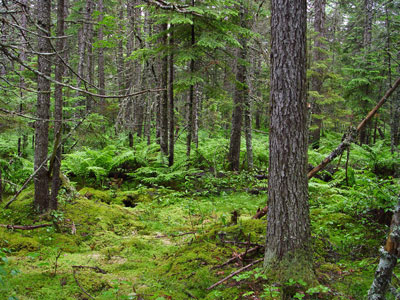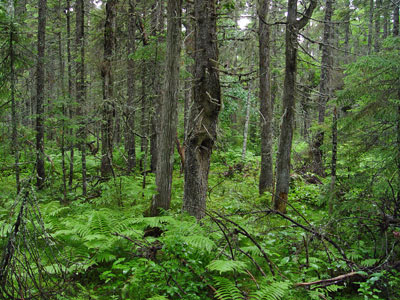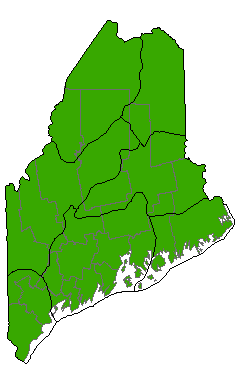DACF Home → Bureaus & Programs → Maine Natural Areas Program → Communities, Plants, and Animals → Natural Community Fact Sheets → Spruce - Fir Wet Flat
Printer Friendly Fact Sheet - 840 KB pdf (Get a free copy of Adobe Acrobat Reader)
Spruce - Fir Wet Flat
Scientific Name: Spruce - Fir - Cinnamon Fern Forest; State Rank: S4

- Community Description
- Soil and Site Characteristics
- Diagnostics
- Similar Types
- Conservation, Wildlife and Management Considerations
- Distribution
- Characteristic Plants
- Associated Rare Plants
- Associated Rare Animals
- Examples on Conservation Lands You Can Visit
Community Description: This natural community is a fairly homogeneous forest type in which red spruce, black spruce, or red-black spruce hybrids grow on poorly drained, level to gently sloping sites. Balsam fir may be present in regenerating patches or stands but tends to give way to the longer-lived spruces over time. Stands often form even-aged blocks hundreds to thousands of acres in size. The even-aged structure likely results from the past influences of spruce-budworm, fire, harvesting, blowdowns, or a combination of multiple factors.
Cinnamon fern and three-seeded sedge are typical in these types statewide. In northern Maine, understory herbs and shrubs are sparse, and the forest floor is dominated by a dense carpet of mosses -- typically Sphagnum species, three-lobed bazzania, and red-stemmed moss. Dwarf heath shrubs may be abundant at St. John Valley sites, which approach boreal ‘muskeg’. In southern Maine, red maple may be sub-dominant. At sites near the coast, skunk cabbage may be a prominent understory species. Back to top.

Soil and Site Characteristics: Sites usually occur along drainages or low flats where soil remains moist throughout the growing season and may be saturated or temporarily flooded in the springtime. The substrate is acidic mineral soil and may be very stony, with or without an organic layer (<30 cm) on top. More information is needed statewide to determine if this type should be split into two separate types, reflecting northern and southern Maine variants. Back to top.
Diagnostics: Sites occur on moist to saturated mineral soils, usually with a dense carpet of mosses and liverworts. Closed canopies are dominated by spruce (>40% cover), or are rarely more open where red maple or northern white cedar mixes with spruce. Wetland plants occur in the herb layer, usually including cinnamon fern and three-seeded sedge. Back to top.
Similar Types: Other spruce - fir types occur on better-drained upland soils and gentle to steeper slopes. Red Maple Swamps can be similar but will have more red maple and less spruce and fir. Black Spruce Bogs can have similar species composition (especially where black spruce is dominant) but occur on peat deposits (>30 cm) rather than on mineral soils. Back to top.
Conservation, Wildlife and Management Considerations: Nearly all known occurrences of this community type in Maine have been harvested in the past, and many have a history of natural disturbance such as fire or spruce-budworm. Large (>1000 acres) examples free from human disturbance are scarce. Forest management with natural regeneration generally does not with result in conversion of this type. Studies on some examples on public and private conservation lands may provide further information on the natural dynamics in these systems.
These stands may serve as deer wintering areas and may also provide habitat for pine marten and Canada lynx, depending on the age and successional stage. This community type may be used as nesting habitat by a number of coniferous forest specialist bird species, including the yellow-bellied flycatcher, sharp-shinned hawk, black-backed woodpecker, pine grosbeak, green heron, black-throated green warbler, blackburnian warbler, common yellowthroat, Wilson's warbler, spruce grouse, blackpoll warbler, and the rare rusty blackbird. Back to top.
Distribution: Statewide, more common and extensive northward. Characteristic of the Laurentian Mixed Forest Province and New England - Adirondack Province. Landscape Pattern: Large Patch. Back to top.


Characteristic Plants: These plants are frequently found in this community type. Those with an asterisk are often diagnostic of this community.
- Canopy
- Black spruce*
- Larch
- Northern white cedar
- Red maple
- Red spruce*
- White pine
- Sapling/shrub
- Alder*
- Balsam fir
- Black huckleberry*
- Mountain holly*
- Red maple
- Wild-raisin
- Dwarf Shrub
- Leatherleaf*
- Lowbush blueberry*
- Rhodora*
- Sheep laurel*
- Herb
- Bunchberry
- Cinnamon fern*
- Dwarf raspberry*
- Goldthread
- Skunk cabbage
- Three-seeded sedge*
- Bryoid
- Red-stemmed moss*
- Sphagnum mosses*
- Three-lobed bazzania
There are no documented examples of rare plants associated with this natural community.
- Rusty blackbird
Examples on Conservation Lands You Can Visit
| Example | County |
|---|---|
| Chamberlain Lake Public Lands | Piscataquis Co. |
| Round Pond Public Lands | Aroostook Co. |